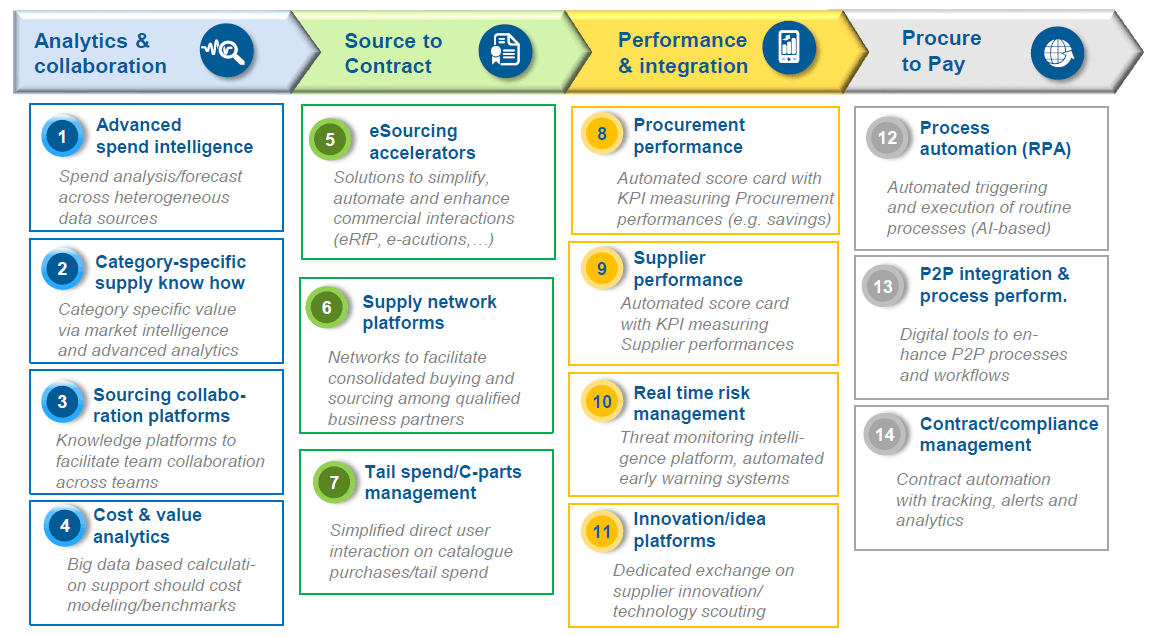The Digital Solution Navigator provides an overview of the software solutions and their functions in a total of 14 fields of action.
Step by Step to
Digital Procurement
According to a survey by German digital association Bitkom, 37% of all companies have major problems coping with digitization. Especially in procurement, decision makers face countless issues.
Most companies already know that digitization is a long-term process that cannot be achieved in one fell swoop. This raises the question of where to start, and what solution is best suited to a company’s specific structures; after all, there is no one-size-fits-all solution. A fully digitized company will only work efficiently if all the processes are interlinked and the software used in different areas is integrated.
So, it is important to question your own processes, to recognize their current level of maturity, and to consider strategic procurement goals. Only then can you define the next steps in digitization and decide on the appropriate solutions.
Your company’s level of procurement maturity can be determined by looking at six different areas. A comparison with your peer group (companies of a comparable size and line of work) as well as with strategic goals in procurement will show how well developed your procurement department is, and where the largest gaps lie. You could also use further analyses and benchmarks to determine the value of individual categories’ contributions to strategic procurement goals.
For a deeper analysis of your procurement’s digital maturity, you can conduct a survey including not only decision makers but also representative employees and suppliers. Management should also be asked about digitization goals. The results can be analyzed using various indicators, and then compared with your peer group. This is how your company can find out what stage of the digital transformation it is at. Management will also be able to find out how employees feel about procurement’s digital maturity and how open-minded they are to further development.
The areas where digitization will be worthwhile can then be defined, based on the survey results. This can be done in workshops, where you evaluate the investment and impact, and develop a roadmap for implementation.

A company’s first move should be to implement digitization projects that bring quick wins. The Digital Solution Navigator (DSN) is ideal for pinpointing which tools are appropriate. It provides an overview of software solutions and their functions in a total of 14 action areas. It also helps companies to navigate the vast supply maze. Continuously screening suppliers on the market and engaging with them regularly ensure the DSN is always kept up to date.
The Digital Solution Navigator provides an overview of the software solutions and their functions in a total of 14 fields of action.
One of the first steps in procurement digitization in many companies is the Procure to Pay process. This entails introducing catalog solutions, integrating suppliers into platforms or directly into ERP, and automating the billing process. We can use the example of an international airport that introduced a Procure to Pay system to optimize internal processes to prove that this can bring significant improvements. The system increased transparency and efficiency through automation, and the maverick buying rate went down by 30%. Improving the invoice process, from receipt through to payment, was another of the company’s goals. This reduced invoice processing time by 80%. Significant savings were also made by applying automatic discounts.
In the past, however, many companies have developed standalone solutions. These require time-consuming manual actions and can be prone to error, making it a better option to switch to an integrated platform. With so many tools evolving and new providers appearing on the market, it is worth regularly reviewing your software landscape for possible improvements.
Advanced analytics is an area in which strategic procurement can be significantly enhanced and new potential realized. Tailor-made cockpits and analyses can provide transparency for all expenditure. It is possible to use big data methods to analyze large amounts of data and continuously refine analyses, thanks to machine learning. Reports can be generated at any time, providing procurement with an overview across all locations.
A global manufacturing company with central procurement in Europe implemented a solution like this to increase expenditure transparency. As a result, the central procurement team was able to identify savings potential and keep a closer eye on the progress of measures that were being implemented. Within indirect procurement, maverick buying significantly reduced because the new level of expenditure transparency meant that the responsibility for suppliers could be passed on to procurement on an ongoing basis.
The efficiency and impact of the source-to-contract process can be increased using e-sourcing accelerators. These can include not only tools for tender procedures but also eAuctions. Many companies already work with these tools, but often their use is not rolled out company-wide, or restricted to individual product groups. As a result, their full potential is not achieved, and resources are wasted. When used properly, these software solutions can provide a structured and standardized process that significantly reduces response times and improves results by using game theory approaches, pre-calculating scenarios, and providing guidance to buyers. Every document can be stored in one platform and made accessible to other stakeholders. It is possible to integrate e-sourcing accelerators into an existing ERP environment, or to complement the tool landscape as standalone solutions.
Robotic Process Automation (RPA) solutions are increasingly used in procurement to automate and augment manual procurement processes. They relieve buyers and users of time-consuming routine tasks by automatically performing repetitive tasks according to predefined rules. RPA can massively reduce processing times and costs. One example is automatic tender processing, where bids are checked for comprehensiveness and consistency, and suppliers receive direct feedback.
Completely digitizing all your procurement processes will only work if your suppliers are integrated digitally. So, companies that want to embark on or continue their digitalization journey should not only analyze their own level of maturity, but should also consider their suppliers. Suppliers further back in the chain may not have gone digital just yet. This is especially true in industries where many small companies are short of capital. Companies in these industries should support their suppliers on the path to digitization, with technical or financial assistance, for example.
